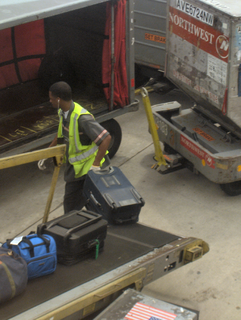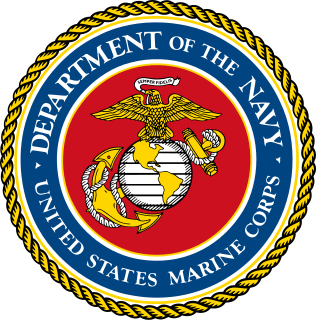
Landing gear is the undercarriage of an aircraft or spacecraft that is used for takeoff or landing. For aircraft it is generally needed for both. It was also formerly called alighting gear by some manufacturers, such as the Glenn L. Martin Company. For aircraft, Stinton makes the terminology distinction undercarriage (British) = landing gear (US).

Force Reconnaissance (FORECON) is one of the United States Marine Corps' special operations capable forces (SOC) which supplies military intelligence to the command element of the Marine Air-Ground Task Force (MAGTF). Force Reconnaissance companies unlike USMC division reconnaissance report to the Marine Expeditionary Force (MEF) and provide direct action and deep reconnaissance during large-scale operations.

Conventional landing gear, or tailwheel-type landing gear, is an aircraft undercarriage consisting of two main wheels forward of the center of gravity and a small wheel or skid to support the tail. The term taildragger is also used, although some argue it should apply only to those aircraft with a tailskid rather than a wheel.

A loadmaster is an aircrew member on civilian aircraft or military transport aircraft tasked with the safe loading, transport and unloading of aerial cargoes. Loadmasters serve in the militaries and civilian airlines of many nations.

In the airline industry, a baggage handler is a person who loads and unloads baggage, and other cargo for transport via aircraft. With most airlines, the formal job title is "fleet service agent/clerk", though the position is commonly known amongst airline employees as a "ramp agent", due to the job's location on the airport ramp (tarmac).

The United States Marine Corps Reconnaissance Battalions are the Special Operations Capable reconnaissance assets of Marine Air-Ground Task Force that provide division-level ground and amphibious reconnaissance to the Ground Combat Element within the United States Marine Corps. Division reconnaissance teams are employed to observe and report on enemy activity and other information of military significance in close operations. The Military Occupational Specialty code for Reconnaissance Marine is 0321.

The Tactical Air Control Party, commonly abbreviated TACP, is a small team of military personnel who provide coordination between aircraft and ground forces when providing close air support.

An arresting gear, or arrestor gear, is a mechanical system used to rapidly decelerate an aircraft as it lands. Arresting gear on aircraft carriers is an essential component of naval aviation, and it is most commonly used on CATOBAR and STOBAR aircraft carriers. Similar systems are also found at land-based airfields for expeditionary or emergency use. Typical systems consist of several steel wire ropes laid across the aircraft landing area, designed to be caught by an aircraft's tailhook. During a normal arrestment, the tailhook engages the wire and the aircraft's kinetic energy is transferred to hydraulic damping systems attached below the carrier deck. There are other related systems which use nets to catch aircraft wings or landing gear. These barricade and barrier systems are only used for emergency arrestments for aircraft without operable tailhooks.
A parachute rigger is a person who is trained or licensed to pack, maintain or repair parachutes. A rigger is required to understand fabrics, hardware, webbing, regulations, sewing, packing, and other aspects related to the building, packing, repair, and maintenance of parachutes.

Air and Marine Operations (AMO) is a federal law enforcement component within U.S. Customs and Border Protection (CBP), an agency of the United States Department of Homeland Security (DHS). AMO's mission is to protect the American people and nation's critical infrastructure through the coordinated use of air and marine assets to detect, interdict and prevent acts of terrorism and the unlawful movement of people, illegal drugs, and other contraband toward or across the borders of the United States. Air and Marine Operations Agents and Officers are endowed with the authority to enforce Title 8 and Title 19 (Customs) of the United States Code in addition to the general law enforcement powers bestowed upon federal law enforcement agents.

The United States Army Air Assault School, officially the Sabalauski Air Assault School (TSAAS), is a Army Forces Command Table of Distribution and Allowances unit located at Fort Campbell, Kentucky. Its primary task is training leaders and soldiers assigned to the 101st Airborne Division (AASLT), other United States Army units, and United States Armed Forces service members. The school is named for Command Sergeant Major Walter James Sabalauski.
Assault Support is one of the six functions of United States Marine Corps aviation and comprises those actions required to airlift personnel, supplies or equipment into or within a battle area by helicopters or fixed-wing aircraft. It provides the Marine Air-Ground Task Force commander the ability to concentrate his strength against selected weaknesses using speed and surprise. It also provides operational and tactical mobility as well as logistics support to the Marine Air-Ground Task Force. It is used to focus combat power at the decisive place and time to achieve local combat superiority.

The United States Marine Corps is organized within the Department of the Navy, which is led by the Secretary of the Navy (SECNAV). The most senior Marine commissioned officer is the Commandant of the Marine Corps, responsible for organizing, recruiting, training, and equipping the Marine Corps so that it is ready for operation under the command of the unified combatant commanders. The Marine Corps is organized into four principal subdivisions: Headquarters Marine Corps, the Operating Forces, the Supporting Establishment, and the Marine Forces Reserve.

Jumpmasters are the expert paratroopers in an airborne unit who train and teach the military techniques for jumping from airplanes. They are responsible for training soldiers who enter Army Airborne School into paratroopers and managing airborne jump operations in airborne units across all branches of services.

Helitack crews are teams of wildland firefighters who are transported by helicopter to wildfires. Helicopters provide rapid transport, enabling helitack crews to quickly respond and assess a wildfire situation. Helitack crews may land near a wildfire or, if equipped and trained, rappel from a hovering helicopter. Once on the ground, crews build firelines using hand tools, chainsaws, and other firefighting tools. They often remain overnight in remote locations. After they have completed their assignment, crew members may pack up to 120 pounds of equipment over difficult terrain to reach a pick-up point. Rappellers often prepare helispots that provide better access to a fire. Helicopter crew members may also perform other duties such as tree falling, firing operations, and managing helibases.
The Marine Corps Test Unit 1, or MCTU #1, was an experimental testing unit of the United States Marine Corps. It was established outside the Fleet Marine Force for the development of specialized tactics, techniques and organizational concepts, and to evaluate its tangible employment in the nuclear age. It reported directly to the Commandant of the Marine Corps.

The Helicopter Flight Rescue System (HFRS), also known as the Helicopter External Transport System (HETS), is a helicopter insertion and extraction tool which as under the Canadian Aviation Regulations (CARs) is authorized for use in Forest Fire Fighting, Law Enforcement, and Search and Rescue. The system is often referred to as "Long Line", "Short Haul", and other terms, and is similar to other helicopter long line systems in use throughout the world.
The Joint Air Delivery Test and Evaluation Unit (JADTEU) is a tri-service unit is an Air Warfare Centre Unit located at RAF Brize Norton. Commanded by a Lieutenant Colonel, it has a combined strength of approximately 115 military personnel and civil servants. Its primary role is to conduct operational trials and evaluation and to develop the delivery by air of personnel, machines and materiel on behalf of sponsors. In addition it provides advice/recommendations to MOD sponsors, other government departments, civilian industry and foreign governments on all air transport matters. It received ISO 9001 accreditation in 1997, this a requirement of holding Design Approved Organisation Scheme (DAOS) approval.

A cargo hook is a device suspended below a helicopter and allows the transport of external loads during flight. Common terms for this operation include slingwork, underslung loads, external loadwork, and external load operations.
















